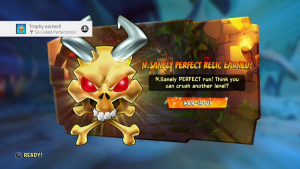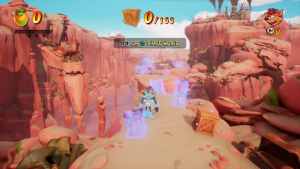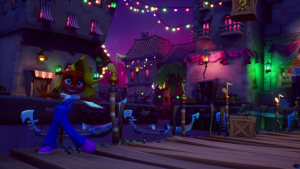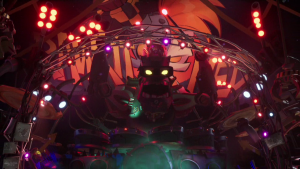Nintendo had Mario. Sega had Sonic the Hedgehog. And for Sony during the formative years of their first game console nothing was more synonymous with the Playstation brand than Crash Bandicoot. The original “Crash Bandicoot” game released at the perfect time as great 3D platforms were few & far between due to the genre just gaining a solid footing. With copious, varied levels featuring collectibles & unlockables galore, “Crash Bandicoot’s” longevity came from players attempting to gain 100% completion while enjoying the addictive, though challenging platforming action. With the success of “Crash Bandicoot” came the birth of a highly-acclaimed franchise featuring not only sequels to the original iteration, but also spin-offs including a kart racer that too would be remade for eighth generation consoles just like its predecessors.
But the big question for gamers was when we would get a proper sequel to a game that was released on the original Playstation. The time had finally arrived and “Crash 3” was getting a proper sequel with yours truly excited to relive the days of old while hopefully enjoying the new tools & methods placed in this platformer.
Did I Complete “Crash Bandicoot 4: It’s About Time”?
Like the original entries, “Crash 4” is all about moving across various levels as fast as possible while avoiding sure death via one-hit kills (that is if the character hasn’t picked up a protection mask usually scattered around a majority of the maps). The challenging platforming that made the original entries so memorable returns here with some new ideas to prevent players from thinking things are getting rather stale when going through the game’s story mode – a mode that will last anywhere from six to ten hours depending on the player’s skill and how much side content they take in before the credits roll. With each completed stage comes not only the opening of the next level to continue the story, but also sub-levels that are both automatically unlocked and those specifically connected to collectibles like “Video Tapes” that show Crash & Coco’s origins and/or stage-specific “Bonus” areas. “Crash 4” doesn’t make it easy for the player in an effort to get the perfect ending as someone’s skills will be put to the test in near maniacal fashion.
Players looking to get full completion will have their work cut out for them as it will take a minimum of four playthroughs to attain all the gems (some can only be obtained by finishing each level while collecting all the fruits, destroying all the crates & only dying no more than three times). Players will also have to complete every stage in “N. Verted Mode” where the stages become mirrored versions of their original presentation; as well as beating all the time trials. I took solace in simply completing the story on “Modern” difficulty (a setting that allows for checkpoints & infinite retries) rather than the “Retro” difficulty setting (limited lives that, when emptied, makes the player replay the entire level), finishing the nine “Timeline” side missions featuring three other characters other than Crash & Coco, trying out the local multiplayer options, and picking up several miscellaneous trophies.
Did “Crash Bandicoot 4: It’s About Time” Live Up to the Hype?
As expected from a “Crash Bandicoot” game no matter the era, “Crash 4” focuses on presenting a true platforming experience that is as challenging as it is rewarding. Initially, the player can only play as either Crash or Coco (both pretty much play the same, though Coco’s height seems to make a difference in completing certain jumps). After the original trilogy’s antagonists Neo Cortex & Dr. N. Trophy escape their inter-dimensional prison following the events of “Crash 3”, the space time continuum is torn apart. With the world’s time now in flux, Crash & Coco are tasked with the duty to recover four Quantum Masks. These Quantum Masks add to the prototypical “Crash” gameplay where Crash & crew can jump (or double jump), spin, slide & body slam the ground while avoiding or swatting away enemies through various missions by providing its wearer powers.
The four powers are incredibly unique from one another. The first mask has the ability to turn certain objects invisible while making others visible. Another mask will slow down time as the third can turn Crash or Coco into a living tornado able to survive barreling through a couple of TNT crates. The final mask removes the effect of gravity on the character. While these powers may come across as gimmicky or a simple addition to mix up a gameplay style rooted in the mid 1990s, each present wonderful moments of immaculate platforming. During latter stages, the game will have the player switching from power to power in quick succession in an effort to stop from dying thanks to some elevated laser beams. These Quantum Masks are a wonderful addition to the gameplay that is still just as stellar now as it was over two decades ago.
Though Crash & Coco play almost exactly alike, their three fellow playable characters are not similar in nature. Tawna features a grappling hook that can pull her across certain areas and reach crates unattainable otherwise. Dingodile & Neo Cortex feature guns with different usages. Dingodile’s vacuum gun can not only pull objects toward him, but also help him propel across platforms. Cortex’s gun can turn enemies into platforms with a second shot actually making said enemy into a bouncy version. Unfortunately neither gun has a proper aiming functionality with the player just shooting while hopefully focusing on the target intended. Cortex also has a dash instead of the double jump ability that works well enough.
The stages themselves are truly the stars of this game. From the opening level where the simple jungle setting of Crash’s homeland gives way to the busy nightlife of Mosquito Marsh, and even space itself, almost each area leaves a lasting impression in the best way possible. The level variety is only matched by the amount of stuff contained in said stage including the typical breakable crates & hidden gems, and special traversal options like a railway or wall-running conveyors. With a perfect run of every level comes the unlocking of skins that can be placed on a character in the game’s main hub, the “Dimensional Map” – no money required for micro-transactions, just pure skill. Graphically the game is wonderful to look at with a complementary soundtrack that would work just as well in one of the original “Crash” experiences.
There are multiplayer options, but only locally. One way to play with a friend is by passing the controller during a level depending on the settings chosen such as player two is given control if player one reaches a checkpoint or dies. The versus co-op mode – “Bandicoot Battle” – sticks to the “pass the controller” method during either a series where the competitors attempt to reach a stage’s various checkpoints faster than their opponent (“Checkpoint Race”) or breaking crates in succession to keep the combo meter high (“Crate Combo”). Though the co-op modes are fantastic from a local perspective, the fact there aren’t any options for online multiplayer is very disappointing and removes some of the replay value this game revels in with so many challenges.
There are some technical flaws in regards to the gameplay. Certain sections will require Crash or Coco to ride a jet ski or even a wild animal and the controls can feel a little too stiff. As per the norm with 3D platformers there are times when a character is forced on a 2D plane and can’t accurately judge a jump or how much room there is before said character plummets to their death. The game’s biggest issue definitely ties into certain confusing hit boxes in regards to enemies and even particular levels having odd moments of death without explanation (an issue accented when the character doesn’t die in the same section when performing the same actions after respawning). Thankfully a majority of these aforementioned issues are few & far between with no game-breaking problems like hard crashes, characters unable to move, or horrendous framerate drops. The only real optimization problem is the loading time between stages and the Dimensional Map.
For those hoping to see Crash Bandicoot return to form in 2020 without simply re-making the acclaimed first three games will find themselves satisfied for hours on end no matter if they’re playing by themselves, with friends, or are attempting to get that perfect ending.
Should You Play “Crash Bandicoot 4: It’s About Time”?
A better question may be, “What is your temper like?” As rewarding of an experience “Crash Bandicoot 4” can be, there will be many moments where quitting may seem like the best choice. With that being stated, it’s hard not to recommend those put off by the difficulty to power through because of how gratifying it is to complete some of the game’s more intricate stages. Those who are either old “Crash” players or enjoy difficult platformers will discover so much to enjoy here; making it well worth your time & money. It’s hard to believe that in 2020 a brand new “Crash Bandicoot” game would become a true testament to masterful platforming helped by the best story presentation in the franchise’s history and a plethora of things to do if finishing said narrative isn’t enough. There are very few reasons a gamer shouldn’t give “Crash Bandicoot 4” a purchase unless you can’t stand a concert that ends quicker than scheduled.








